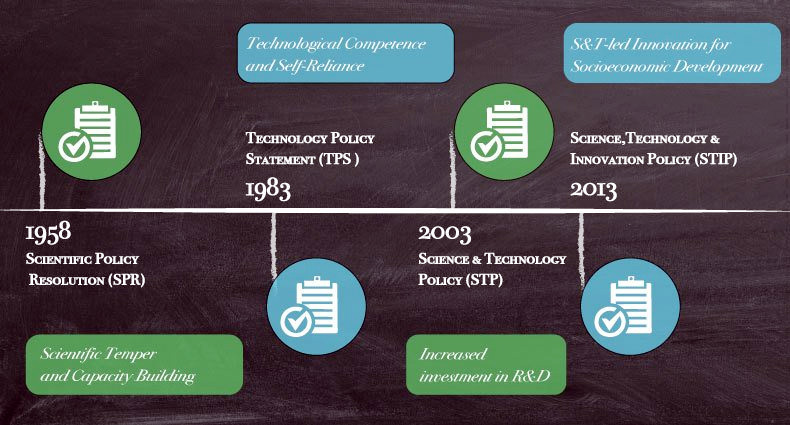Science & Technology
Draft National Science, Technology and Innovation Policy
- 13 Jan 2021
- 8 min read
This article is based on “Building a vibrant science ecosystem” which was published in The Indian Express on 12/01/2021. It talks about the significance of the proposal in the draft National Science, Technology and Innovation Policy (STIP 2020).
Covid-19 pandemic has shown the world that it has to take research in science and technology more seriously than before. In India, the pandemic presented an opportunity for R&D institutions, academia, and industry to work with a shared purpose, synergy, collaboration and cooperation.
With the growing realisation, that science can address many of society’s pressing problems, the Government of India has released a draft National Science, Technology and Innovation Policy (STIP 2020).
The STIP will be guided by the vision of positioning India among the top three scientific superpowers in the decade to come. Apart from it, the policy outlines strategies for strengthening India’s STI ecosystem to achieve the larger goal of Atmanirbhar Bharat.
Novel Ideas of the Policy & their Significance
- Open Science Framework & Inclusiveness: Open Science fosters more equitable participation in science through increased access to research output, greater transparency and accountability in research.
- Apart from this, it would ensure better resource utilisation through minimal restrictions and a constant exchange of knowledge between the producers and users of knowledge.
- This framework will be largely community-driven and supported with necessary institutional mechanisms and operational modalities.
- One Nation, One Subscription & Democratization: The STIP envisions free access to all journals, Indian and foreign, for every Indian against a centrally-negotiated payment mechanism.
- In the present mechanisms, consumers of knowledge such as line departments, innovators, industry, the society at large, etc., do not have access to these research journals.
- Hence, the policy seeks to democratise science by providing access to scholarly knowledge to not just researchers but also to every individual in the country.
- Science & Gender Parity: India has valued women’s participation in science and education from ancient times.
- Some of the earliest women scientists, including Leelavati, Gargi, and Khana, made significant contributions to mathematics, natural science, and astronomy.
- Over the last six years, women’s participation in S&T has doubled in India; however, women’s overall participation in R&D continues to be only about 16%.
- Therefore, the policy has envisaged gender parity by addressing career breaks for women by considering academic age rather than biological/physical age.
- Apart from this, it proposes an inclusive culture that'll be facilitated through the equal opportunity candidates from rural-remote areas, marginalised communities, differently-abled, Divyangjans, irrespective of their socio-economic backgrounds.
- Traditional Knowledge & Carving Own Niche: The policy envisages establishing an institutional architecture to integrate Traditional Knowledge Systems (TKS) and grassroots innovation into the overall education, research and innovation system.
- This focus on indigenous know-how may help India shine globally, standing on its merit and unique technologies based on timeless ancient wisdom curated/enhanced by modern science and technology.
- Collaboration & Ease of Doing Research: The proposed Science Technology Innovation Observatory will have an important governance role in the collaboration networks.
- The policy proposes creating a National STI Observatory that will act as a central repository for all kinds of data related to and generated from the STI ecosystem.
- Further, an STI Development Bank will be set up to facilitate a corpus fund for investing in direct long term investments in select strategic areas.
Way Forward
- Operationalise Clusters: When the draft policy takes the shape of the actual procedure, it must acknowledge the cluster-based approach and incorporate it.
- Clusters consist of multiple organisations including suppliers, producers, customers, labour markets, HEIs, financial intermediaries, professional and industry associations, regulatory institutions and government departments.
- They nurture strong science and technology research capabilities in a specific domain and help translate these capabilities into applications.
- An example of an electronics hardware cluster is in Silicon Valley.
- Increasing Funding For Research: At 0.6% of GDP, India’s gross domestic expenditure on R&D (GERD) is relatively low compared to other major economies with a GERD-to-GDP ratio of 1.5% to 3%.
- One way to increase R&D spend in the country is to make it attractive for companies to invest.
- In this regard, reformed bureaucracy, tax benefits and market access for the infant companies should also be considered.
- Enabling Research in Disruptive technology: Technologies that are collectively called Industrial revolution 4.0 are undoubtedly the future of science and technology landscape.
- India must take advantage of these disruptive and impactful technologies.
- More research on these associated technologies may positively impact many industries such as defence, education, health etc.
- Science Diplomacy: India should indulge in international S&T engagement and STIP diplomacy.
- This will help in achieving collective and inclusive global development through international engagement by maximising the scope of indigenisation and sustainability for national advancement and promotion of global commons.
Conclusion
India’s STI growth trajectory over recent years has been impressive. Our entry into the club of the top 50 countries in the global innovation Index with a rank of 48 (a massive improvement from 81st place in 2015) speaks volumes for our potential.
To continue this feat, the draft Science, Technology and Innovation Policy contains progressive proposals that could be game-changers for the scientific research community and the way ordinary Indians interact with Science.
|
Drishti Mains Question “India needs science that solves, a technology that transforms and innovation that impacts”. In light of this statement, discuss the draft Science, Technology and Innovation Policy, 2020. |
This editorial is based on “Bridging the Gulf: On Gulf reconciliation summit” which was published in The Hindu on January 12th, 2020. Now watch this on our Youtube channel.





